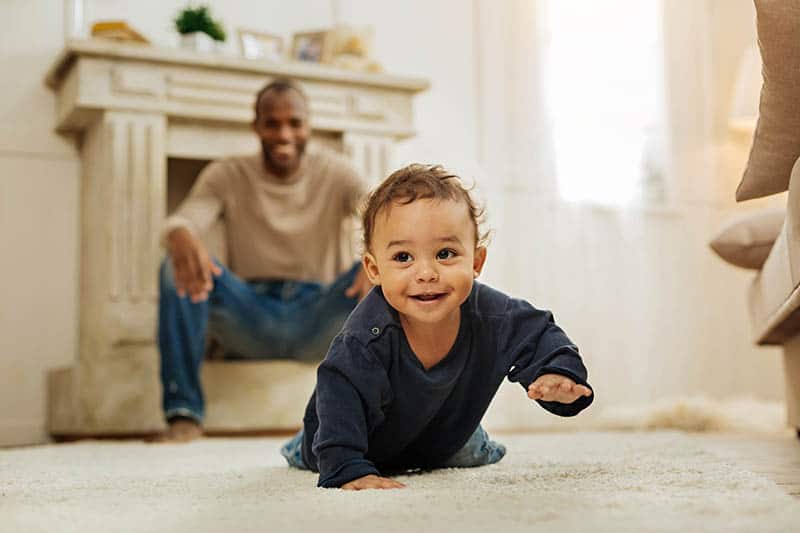If you’re anxious to know when do babies crawl because your little one doesn’t seem to be showing an interest in moving around using her arms and legs, I’m here to tell you not to panic.
Most babies start to crawl between 6 to 12 months of age but it’s important to know that some babies never quite get the hang of crawling and prefer to start cruising and walking instead.
In fact, it’s not uncommon to see a baby that didn’t crawl start walking earlier than her peers who are expert crawlers.
Of course, there are methods you can try to encourage your little one to start moving around using her arms and legs, such as letting her spend more time playing on the floor, rather than sitting in a lounger, for example.
This way, your baby can develop the necessary muscles she needs to crawl, stand up, cruise, and finally, walk. Once she reaches this milestone, there are important babyproofing steps to take to make sure the baby is safe at home.
Unfortunately, you can also expect a sleep regression around the time your little one reaches this developmental milestone, so hang in there, mama!
When Do Babies Start Crawling?
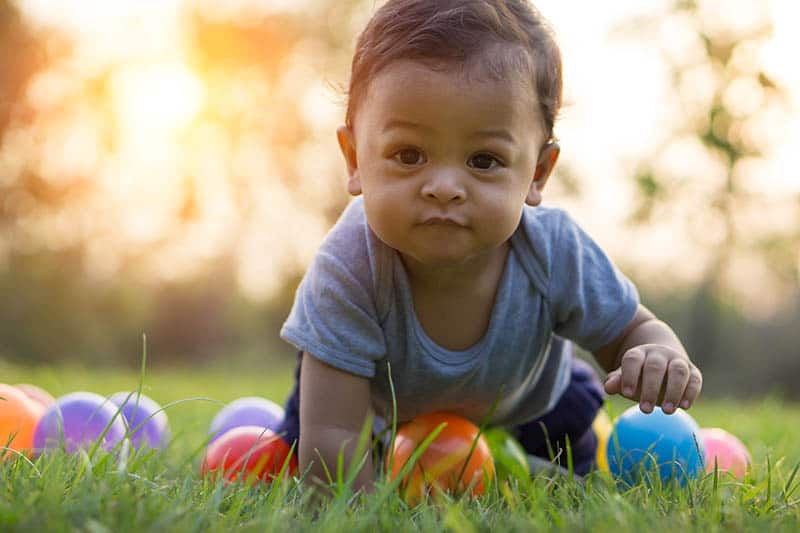
Like many other important developmental milestones in a baby’s life, the crawling stage may start at a different time for every baby. As a rule of thumb, the majority of babies start crawling between 6 to 12 months of age. However, a large number of kiddos discover that they can crawl their way from one spot to another by 8 months of age.
Still, each baby is individual, so don’t worry if your baby isn’t crawling by 8 months or by the time she’s one year old.
Signs that your baby is ready to start crawling
During the first year of your baby’s life, you might notice several signs that your baby is ready to start crawling for the first time. For example, one day she might lift up on her hands and knees, as if she’s ready to start moving forward, only to sit back down again.
Likewise, when she starts rolling over from her stomach onto her back and the other way around, you can expect that she’ll attempt crawling soon. This can also be accompanied by the baby learning how to lift up into a seat when she’s laying on her belly.
You might also notice that when you’re doing tummy time that your baby tries to use her hands and arms to scoot herself forward – these are all cues that will let you know that crawling isn’t too far away.
How To Encourage Your Baby To Crawl
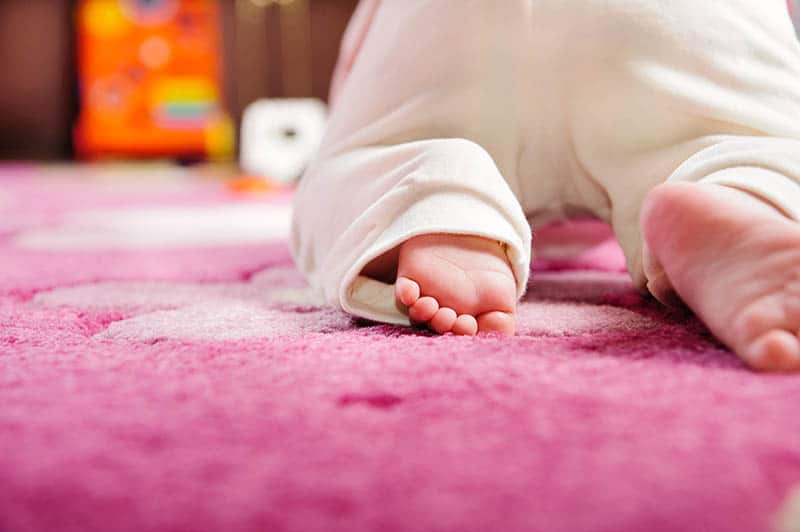
No matter how old your little one is, there are still methods you can try to motivate her to start crawling. Allowing her to work on her muscles or encouraging her to move toward an object to grab it are all excellent ways of getting your baby to start crawling.
1. Tummy time
Essentially an exercise for your little one, tummy time refers to when a baby is placed on her stomach on a flat surface while she’s awake. Some babies enjoy it right off the bat while others want nothing to do with it and will cry until you lay them face-up. This is especially common with younger babies who can’t lift their own heads yet.
However, even if your little one seems to despise being laid down on her belly, this type of baby exercise is really important for her development as it strengthens the necessary muscles she’ll use as she learns how to sit up on her own and – you guessed it – crawl. Of course, these upper body muscles play an important role as she starts walking, too.
The American Academy of Pediatrics (AAP) says that tummy time should become a part of your baby’s daily schedule from the moment you bring her home from the hospital.
But apart from strengthening the upper body and back muscles she needs to crawl and walk, exercising on her tummy has other benefits, too. For example, it prevents the baby from having a flat spot on the back of her head from spending too much time laying down.
Likewise, for younger babies, spending time on their belly helps them learn how to lift up their heads.
Tips to make tummy time more successful
Some babies need some convincing before they warm up to spending time on their belly. Thankfully, there are many ways you can try to make this exercise more enjoyable for your child.
First off, make sure that the baby doesn’t have a dirty diaper or is in a cranky mood. Most experts recommend trying tummy time after the baby gets up from her nap. After you make some room for the baby on the floor, place a couple of toys around her so she’ll be intrigued and want to lift up.
You can use a pillow to give her some support in the beginning (place it under her arms and chest) if she’s protesting too much or you can lay her down on your own belly – this should be much more interesting for her!
Some parents have also found it helpful to place a mirror in front of their baby (just make sure it’s firmly in place) since little munchkins are always fond of mirrors and this might distract her enough to spend a few minutes on her tummy.
You can also lay down on the floor and talk to your baby, sing songs, or do anything else she usually finds funny or relaxing.
How long should tummy time be?
Experts recommend to start off with only a couple of minutes every day and gradually increase the amount of time your baby spends on her belly.
By the 3rd or 4th month of your baby’s life, she should be spending between 20 and 30 minutes on her belly every day until she learns how to roll over all by herself.
2. Offer a favorite toy
Sometimes all it takes for your munchkin to realize they can move from point A to point B is by placing her favorite toy just a little outside her reach to encourage her to move forward. You can also dangle the item in front of the baby to get her attention.
This is not only a terrific way to encourage crawling but also walking. A 2011 study, in fact, found interesting links between babies who were able to use crawling to pick up an item and walking.
For example, if a baby was able to crawl across the room to retrieve an item by the time she was 11 months of age, her chances of walking by the time she was 13 months old were higher.
3. Let baby roam free
While giving your baby plenty of tummy time is important, you should also give her some time to explore the magical world that is your floor on her own, so don’t be in a rush to put your baby back in her lounger or jumper once tummy time is up.
In fact, the more opportunities you give your baby to move around on the floor, the more likely it is that she’ll start crawling.
4. Only use baby gear when necessary
Baby gear . However, such baby gear can slow down your baby’s muscle development because it provides a lot of support.
You can rely on a playpen as an alternative to swings, for example, where your baby can safely play and work on her motor development.
5. Give your baby a break when she needs it
Sometimes, no matter how much you try to entertain your little munchkin on the floor or encourage them to finally start crawling, you’ll still be met with crying and crankiness. Even though crawling is considered an important baby milestone, don’t push too hard when you notice things aren’t going too well.
Give your baby a break and wait a couple of days before trying again to avoid the baby from associating crawling and playing on her belly with negative experiences.
What Are The Different Types Of Crawling?
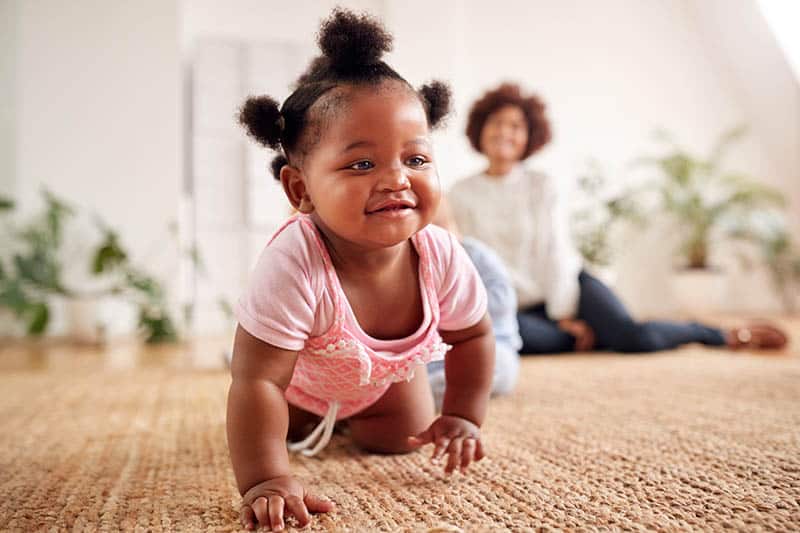
Now that you know the answer to when do babies crawl, you’re going to want to learn more about the different types of crawling. Although when do babies start to crawl? is a question with many answers, generally-speaking there are only 6 different ways a baby can crawl.
1. Classic crawl
The classic crawl is what most parents have in mind when they talk about crawling. The baby is on her hands and knees while moving one arm forward and the opposite leg forward at the same time. The abdomen is lifted up, without touching the ground.
2. Crab crawl
Babies who crab crawl do so by bending their knees as if they’re squatting down, and using their hands to move forward while moving their feet at the same time. Some babies keep one knee on the ground (like in a classic crawl) while the other stays in a squat-like position.
3. Bear crawl
Another crawling style is called the bear crawl. It’s similar to the classic crawl but instead of the baby keeping her elbows and knees on the ground, she lifts them up and they don’t touch the ground as she crawls. It looks quite similar to the Downward Facing Dog yoga pose.
4. Bottom scoot
Some babies prefer scooting on their bottoms to crawling on their hands and knees. In a bottom scoot, the baby uses her legs (sometimes in combination with the arms) to move forward in a scooting or shuffling motion.
5. Commando crawl
The commando crawl is also known as the army crawl. If you’ve ever seen a movie where special forces go on a top-secret mission and make their way through unknown terrain by laying down flat on their bellies while using their elbows and hands to move forward, then you’ve seen a commando crawl in action.
Because the baby is only using her hands and elbows to push up, this is also sometimes called the belly crawl. Most crawlers start off in this position (usually between 5 and 8 months of age) and then move onto other types of crawling once they get the hang of it.
6. Rolling
Instead of relying on her hands, feet, or legs to propel herself from one point to another, a baby who prefers the rolling crawling style simply rolls on her side until she arrives at her destination. Although it doesn’t resemble crawling, it still counts as it since the baby moves from one spot to another.
Can A Baby Skip The Crawling Stage?
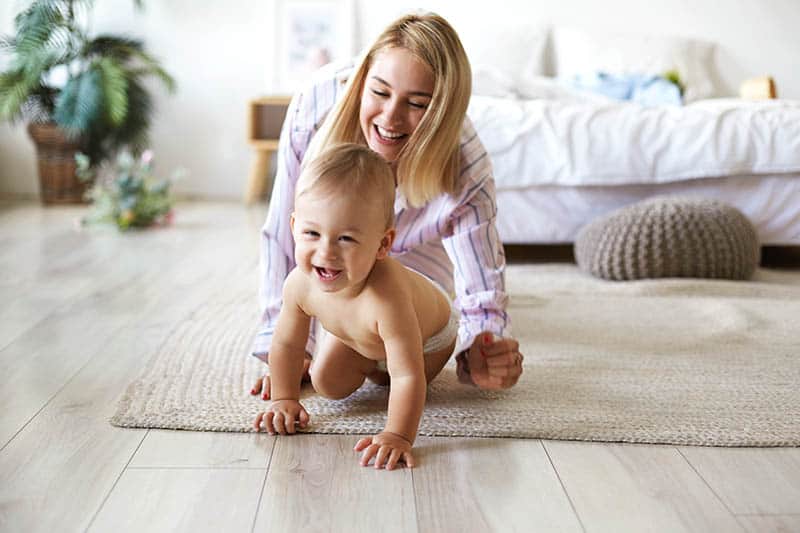
The answer to when do babies crawl is (for some babies) never! During a baby’s development, it’s completely normal for some to skip the crawling phase. Instead, they move right onto trying to stand up on their own and support themselves on furniture to cruise.
After this point, you can expect your little one to start walking sooner or later, so be prepared to babyproof your house if you haven’t done so already!
It’s not unusual for little ones who skip crawling or never quite get the hang of it to start walking sooner than their crawling counterparts. On the other hand, babies who become really good at crawling might be hesitant to start standing up and cruising.
If your pediatrician assures you at your regular checkups that your child’s development is going according to schedule, there’s no need to be concerned about your baby’s crawling habits – or lack of.
How To Prepare For The Crawling Stage
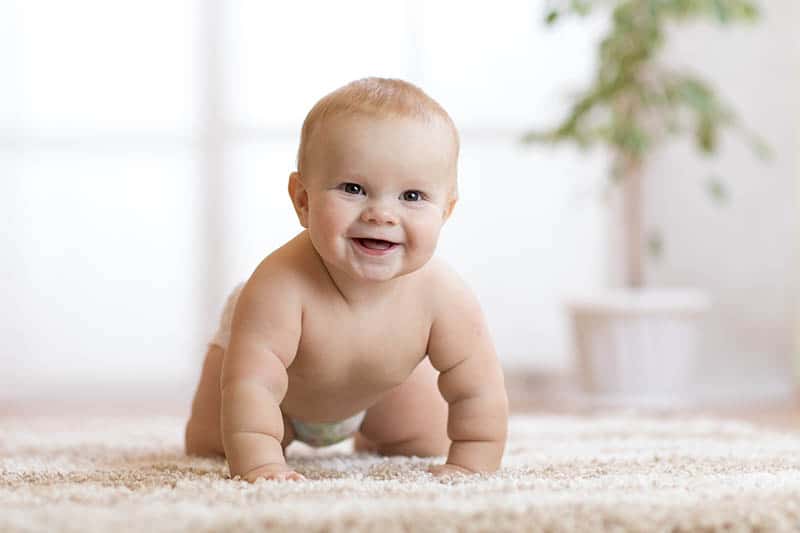
Once your baby starts exploring the world on all fours, there’s no stopping her! But this new skill also brings with it a number of changes. Here’s what you should keep in mind and prepare for as your little one begins showing signs she’s ready to crawl.
Sleep regression
I’m sure you’re less than thrilled that the beginning of crawling marks another sleep regression. Since the beginning of crawling and gaining more mobility is an important part of infant development, however, it’s natural that it will bring about disruptions to their sleeping patterns.
Don’t be shocked if your baby suddenly begins waking up several times in the course of one night, even if they have been a good sleeper so far. Their naps will be affected, too, and they might not sleep as well during the day as they used to, which obviously leads to changes to the nighttime sleep schedule.
There’s also a chance that your munchkin will start standing up in their crib when they don’t want to sleep.
Your baby might be crankier than usual, lose their appetite or experience changes to their eating habits.
Although going through another sleep regression with your child can be difficult, remember that this is not permanent. As soon as she adjusts to these new changes, you’ll be able to rely on a routine again.
Babyproofing
In case you’ve been putting off babyproofing your house, now is the time to do it, otherwise, you’re risking your baby bumping her head on sharp corners and getting into places where she really shouldn’t be.
For example, you’ll need to always shut the bathroom door after you’re done using it. Most of us keep cleaning supplies and other kinds of toxic products in the bathroom, and if your baby gets in there, it could have very tragic consequences.
Place anti-scalding devices onto your faucets that will prevent your baby from getting severe burns in case she manages to get into the bathroom and open the faucet. Also, install toilet locks onto your toilet seat so your little one can’t open and accidentally fall into it.
The same rules apply to all cabinets inside your home that are within your baby’s reach.
Then, you also need to consider the fact that once your baby starts crawling, she’ll start cruising soon afterward. This means she’ll use furniture and other household objects to lift herself up onto her two feet. If those objects aren’t stable or secure enough, she could fall down or have the piece of furniture fall onto her.
If you can’t secure or move the unsafe furniture to another room baby doesn’t have access to, it’s best to put them away until she’s old enough and they don’t pose a risk anymore.
Of course, all electrical outlets need to be covered appropriately so that tiny fingers can’t get into them.
Coffee tables and other furniture that have sharp corners need to be covered since chances are big that your little one will bump her head when she tries to get up. You’ll need to secure your windows, as well, to ensure your baby can’t accidentally fall out.
Of course, you’ll need to install a baby gate in front of every staircase in your house. Some baby gates even come with a pet door to make it easier for the family pet to move throughout the house.
You should also take a look at your window blinds and see if they have a cord that your child could get tangled up in. In case they do, you can either move the cord out of reach or replace them with cordless ones.
If you have pets, such as dogs or cats, who have their food bowls on the ground, you’ll need to make sure they’re out of your baby’s reach. Before your little one can learn to stay out of your pet’s food and water bowls, it’s best to keep them in a separate room where your baby can’t reach it.
Finally, double-check if there are any hazards inside your home that you might have overlooked. Remember that as adults we have a completely different perspective on the world and might completely overlook an item that poses a significant danger to our kids.
If necessary, you can lay down on the floor and try to see the world from your baby’s point of view. This will make it easy to spot any other potential dangers.
When To Talk To A Doctor
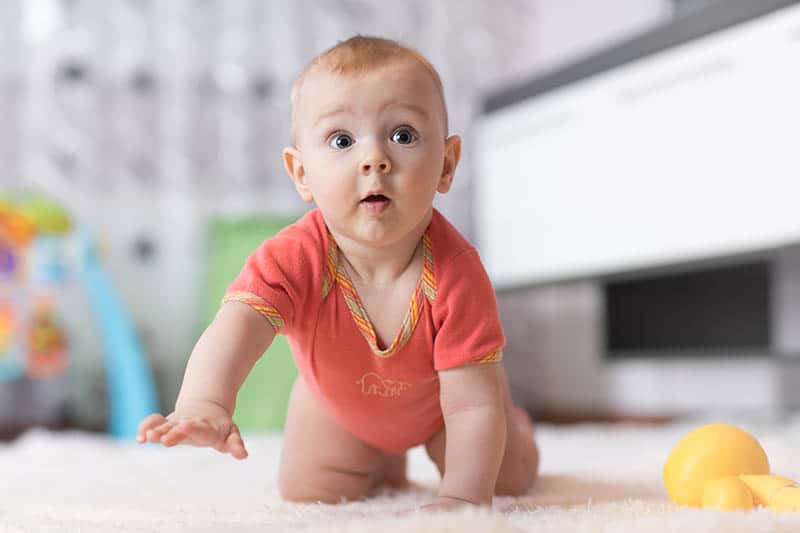
When it comes to locomotion, every child is different. Try to be patient and not panic even if your baby starts approaching her first birthday without having shown an interest in crawling. After all, answering when do babies crawl can be quite difficult since it really depends on the child.
However, you should talk to a doctor if you notice that your little one isn’t trying to cruise, stand up, or use their arms and legs to move around after she turns one year old. They’ll be able to tell you if there is a developmental issue at play and will give you advice on the next steps to take.
Final Thoughts
When we talk about when do babies crawl, you need to understand that every baby develops at her own pace and might not follow the pace of her peers.
She might start crawling at 6 months but she might also completely skip this stage and start showing an interest in walking, instead. As long as she’s healthy and your doctor hasn’t noticed any issues, there’s no need to worry.
Perhaps your baby is already crawling but you haven’t registered as such. Some babies prefer to roll on their side rather than move using their hands and feet, just because they feel like it! There’s no rhyme or reason regarding your child’s crawling preferences, so it’s best to go with the flow and avoid comparing your child to others.
Just remember to give her plenty of tummy time and avoid excessive use of baby jumpers or loungers that could slow down the development of her muscles. Your baby will need them to take on the world!
References:
- “Babies should sleep on their backs, play on stomachs” by David Ma, published on the American Academy of Pediatrics website on August 24, 2009. Accessed October 12, 2020.
- “Transition From Crawling to Walking and Infants’ Actions With Objects and People” by Lana B. Karasik, Catherine S. Tamis‐LeMonda, and Karen E. Adolph, published in the Child Development journal on May 5, 2011. Accessed October 12, 2020.
Like this post? Please share or pin it for later. You can also stay in the loop and follow us on Facebook, Instagram or Pinterest.

This post contains affiliate links. Please see our full disclosure for more info.

